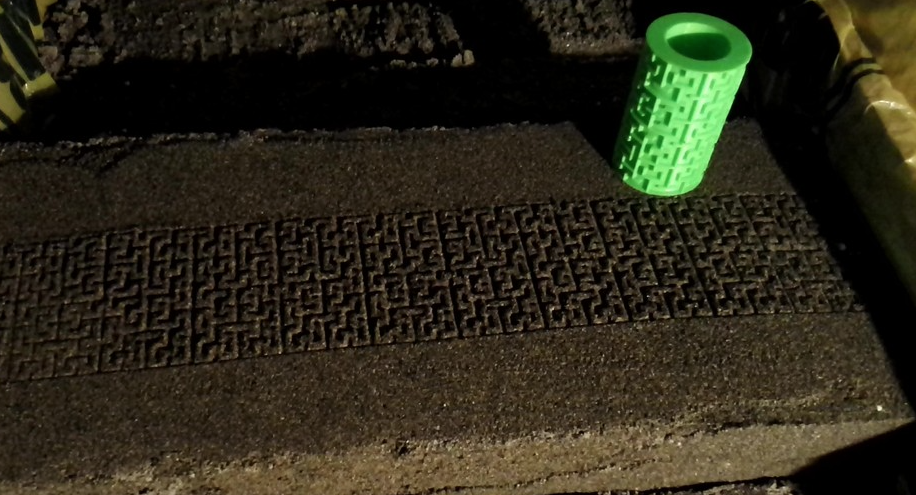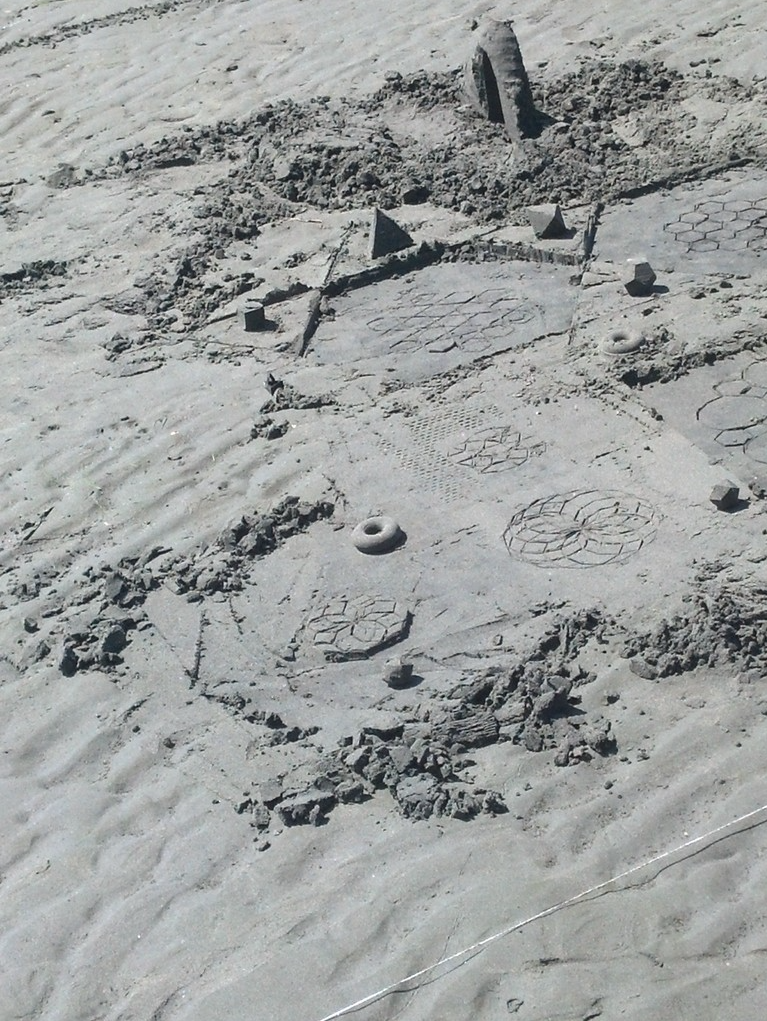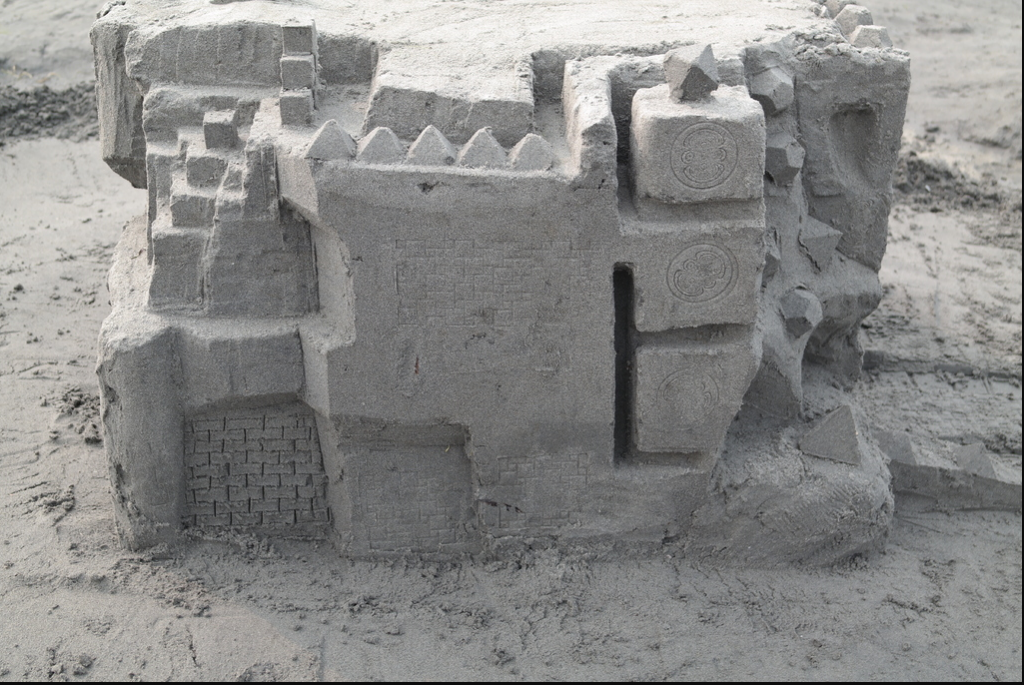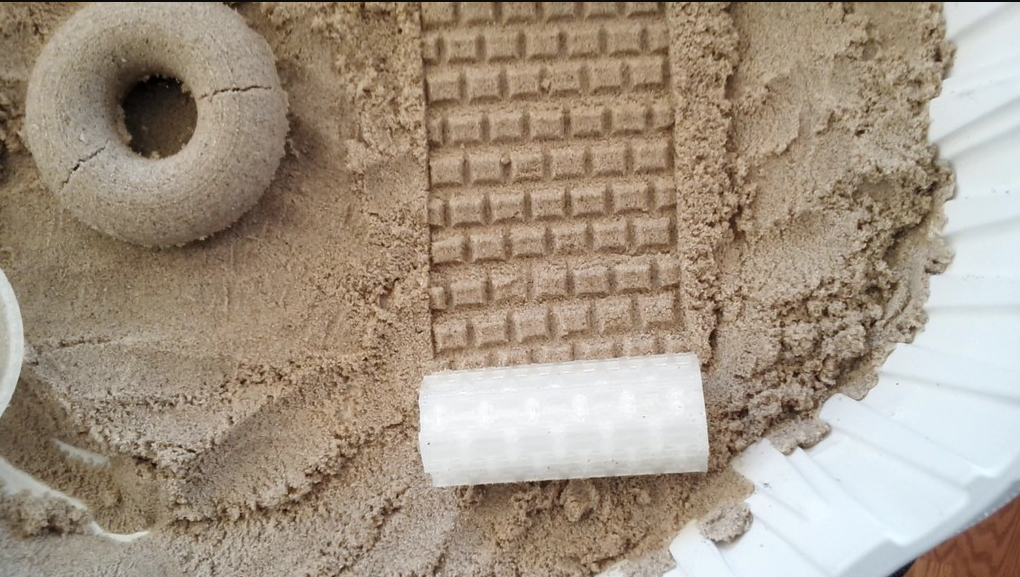Build Castles at the Beach with 3D Printed Mathematical Sand Molds
Want to spend the last beautiful weeks leading into Fall relaxing at the beach but worried there won’t be enough mathematics there to keep you entertained? Fret no more! Professor Will Webber, faculty member in Whatcom Community College’s Math Department, has created a fantastic way to enjoy the beauty of mathematics and get a tan at the same time.
 It began with the quest to create more interesting sand castles. The standard plastic mold sets sold provide a couple turrets and a crenelated tower or two but that’s the end of it. First, Webber decided to experiment with ways to make patterns on the walls of the castle.
It began with the quest to create more interesting sand castles. The standard plastic mold sets sold provide a couple turrets and a crenelated tower or two but that’s the end of it. First, Webber decided to experiment with ways to make patterns on the walls of the castle.
The first attempt involved the creation of flat panels, but Webber quickly realized the limitations of that design:
“It has been an interesting summer of design and redesign. We started with the notion of flat panels to add interesting patterns to castle walls, but we had several issues with the panels. These issues included the printer not printing properly (the panels had a tendency to warp), and not cutting into the sane well enough. So, we moved on to the idea of rollers.”
 The rollers work on the same basic principle as a paint roller except that rather than having a fuzzy nap – a nightmare in a sandy situation – the roller has a raised pattern meant to leave an impression in a soft surface such as sand. Webber created several types of rollers for creating frieze patterns, placing a series of
The rollers work on the same basic principle as a paint roller except that rather than having a fuzzy nap – a nightmare in a sandy situation – the roller has a raised pattern meant to leave an impression in a soft surface such as sand. Webber created several types of rollers for creating frieze patterns, placing a series of  windows on a grid, and there are two based on a space filling Hibert curve that can be used to create a labyrinth. These 3D printed rollers are not only good for use in the sand; Webber’s daughter even used them to roll a texture into part of the cake she was baking for the county fair!
windows on a grid, and there are two based on a space filling Hibert curve that can be used to create a labyrinth. These 3D printed rollers are not only good for use in the sand; Webber’s daughter even used them to roll a texture into part of the cake she was baking for the county fair!
After exploring the rollers, Webber moved on to the creation of a series of shape molds. Here’s where it becomes very clear how much he enjoys playing with mathematical ideas.
“Being a polydedral guy,” Webber said, “I started with the platonic solids. Then for kicks I did one of the Archimedean solids and my favorite Johnson solid. It is not every day that you see a triangular hebesphenorotunda, and even more rare that you see one at the beach.”
And he’s right, I simply cannot remember the last time I came upon a triangular hebesphenorotunda by the seaside.
 Not one to take a project like this halfway and then abandon it, Webber began to create cookie cutter-type molding tools as well as bucket molds to spice up the sand castle. The cutters were printed in a variety of polygons with from 3 to 12 sides and are ideal for tiling a plane since each side is of equal length. In addition, he created cutters to make the shapes for arches, windows, and doors – the arches being catenary curves provide an opportunity to lure passersby into conversation by noting that “the lintel has a point that comes form a hyperbolic sine of an absolute value function.”
Not one to take a project like this halfway and then abandon it, Webber began to create cookie cutter-type molding tools as well as bucket molds to spice up the sand castle. The cutters were printed in a variety of polygons with from 3 to 12 sides and are ideal for tiling a plane since each side is of equal length. In addition, he created cutters to make the shapes for arches, windows, and doors – the arches being catenary curves provide an opportunity to lure passersby into conversation by noting that “the lintel has a point that comes form a hyperbolic sine of an absolute value function.”
 The bucket molds are still a work in progress as Webber would like to create designs that incorporate fractals. Since he had decided to submit these designs to the Thingiverse Summer S.T.E.A.M Challenge for Math: Build a Castle (his was the winning entry!) he had to wrap up the design of the buckets in a simpler fashion. In doing so, he didn’t sacrifice any of the elegance of the design:
The bucket molds are still a work in progress as Webber would like to create designs that incorporate fractals. Since he had decided to submit these designs to the Thingiverse Summer S.T.E.A.M Challenge for Math: Build a Castle (his was the winning entry!) he had to wrap up the design of the buckets in a simpler fashion. In doing so, he didn’t sacrifice any of the elegance of the design:
“I do have simpler designs ready. One is inspired by my wife who insisted that we should have some kind of top for towers that had merlons with heights related to the abacabadabacaba pattern related to binary counting. As it has fractal properties, it fit in with what I was trying to do. The other bucked mold is a parabolic hyperboloid with some exponential bumps added to it.”
 See? It’s fun for the whole family and educational too. It sure beats the heck out the castles I built as a kid; I think I’d better go back to the beach and try again.
See? It’s fun for the whole family and educational too. It sure beats the heck out the castles I built as a kid; I think I’d better go back to the beach and try again.
Let us know if you decide to print out some of these molds to make waves of your own in the 3D Printed Sand Castle Math forum thread over at 3DPB.com.
Subscribe to Our Email Newsletter
Stay up-to-date on all the latest news from the 3D printing industry and receive information and offers from third party vendors.
Print Services
You May Also Like
New Business: Temporary, Migratory, & Modular 3D Printed Architecture
If we look at potentially emerging 3D printing businesses, then architecture has not been fully explored. Yes, there is a lot of house 3D printing going on worldwide. From deployable...
3D Printing News Briefs, April 19, 2025: Material Extrusion Standard, Metal Powder, & More
In today’s 3D Printing News Briefs, we’re covering a proposed standard for material extrusion, before moving on to business and metal powder. We’ll end with a commercial store’s robotic 3D...
Japan Unveils World’s First 3D Printed Train Station
Japan is now home to what we believe is the world’s first train station built with 3D printing technology. Located in Arida City, just south of Osaka, the new Hatsushima...
restor3d Raises $38M to Expand 3D Printed Orthopedic Implants
Backed by $38 million in new funding, restor3d is pushing ahead with the launch of four personalized implant lines, set to roll out in 2025 and 2026. This latest venture...


























